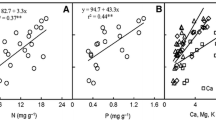Summary
The CO2 assimilation of primary foliage of red maple (Acer rubrum L.) and red oak (Quercus rubra L.), and of regrowth foliage produced in response to simulated insect defoliation, was measured throughout the season by infrared gas analysis: parallel measurements of leaf conductance were obtained by ventilated diffusion porometry. The rate of net photosynthesis, measured at a quantum flux density of 1,150 μmol m-2s-1, of primary foliage of both species increased from slightly negative values to about 5 μmol m-2s-1 by early June. Thereafter the rate of photosynthesis of maple slowly declined to about 4 μmol m-2s-1 before onset of a senescent decline in early September, while that of oak slowly increased to about 8 μmol m-2s-1 before onset of senescence. Manual defoliation to simulate insect attack in mid-June elicited refoliation proportional to the severity of defoliation in early July. After 100% defoliation, fully expanded regrowth foliage of maple, but not of oak, had a rate of net photosynthesis from mid-July through September that was about 50% higher than in the primary foliage of undefoliated trees. A 30 to 60% enhancement of photosynthesis of residual primary foliage remaining on 50 and 75% defoliated trees during July was also observed. The seasonal patterns of CO2 exchange of primary and regrowth foliage, and the enhancement of CO2 assimilation in residual foliage, was paralleled by similar changes in leaf conductance to water vapour.
Carbon budgets of leaf canopies of each species showed that the net assimilation of the leaf canopy of both species ranged from 19 to 67% more than what would have been expected solely from replacement of leaf area. This response was greater in maple than in oak, presumably a reflection of the high rate of CO2 assimilation of regrowth maple foliage compared with that of the undefoliated control in maple.
The increased CO2 assimilation of regrowth maple foliage and the increases in CO2 assimilation of residual primary foliage after defoliation offer evidence that heretofore unanticipated physiological mechanisms may be important to perennial species coping with herbivory.
Similar content being viewed by others
References
Byrne GF, Rose CW, Slatyer RO (1970) An aspirated diffusion porometer. Agr Meteorol 7:39–44
Caldwell MM, Richards JH, Johnson DA, Nowak RS, Dzurec RS (1981) Coping with herbivory: Photosynthetic capacity and resource allocation in two semiarid Agropyron bunchgrasses. Oecologia (Berlin) 50:14–24
Campbell RW, Sloan RJ (1977) Forest stand responses to defoliation by the gypsy moth. Forest Sci Monograph 19, p 34
Collins S (1961) Benefits to understory from canopy defoliation by gypsy moth larvae. Ecology 42:836–838
Heichel GH, Turner NC (1972) Carbon dioxide and water vapour exchange of bean leaves responding to fusicoccin. Physiol Plant Pathol 2:375–381
Heichel GH, Turner NC (1976) Phenology and leaf growth of defoliated hardwood trees. In: Anderson J, Kaya H (eds) Perspectives in forest entomology. Academic Press, New York, pp 31–40
Hodgkinson KC (1974) Influence of partial defoliation on photosynthesis, photorespiration, and transpiration by lucerne leaves of different ages. Aust J Plant Physiol 1:561–578
Kitchell JF, O'Neill RV, Webb D, Gallepp GA, Bartell SM, Koonce JF, Ausmus BS (1979) Consumer regulation of nutrient cycling. Bioscience 29:34–38
Kulman JH (1971) Effects of insect defoliation on growth and mortality of trees. Ann Rev Entomol 16:289–324
Mattson WJ, Addy ND (1975) Phytophagous insects as regulators of forest primary production. Science 190:515–522
Mooney HA, Gulmon SL (1982) Constraints on leaf structure and function in reference to herbivory. Bioscience 32:198–206
Morrow PA, LaMarche VC Jr. (1978) Tree ring evidence for chronic insect suppression of productivity in subalpine Eucalyptus. Science 201:1244–1246
Morrow PA, and Slatyer RO (1971) Leaf temperature effects on measurements of diffusive resistance to water vapour transfer. Plant Physiol 47:559–561
Penning de Vries FWT (1975) The cost of maintenance processes in plant cells. Ann Bot 39:77–92
Stephens GR (1971) The relation of insect defoliation to mortality in Connecticut forests. Conn Agric Exp Stn Bull 723, p 16
Stephens GR (1981) Defoliation and mortality in Connecticut forests. Conn Agric Exp Stn Bull 796, p 13
Stephens GR, Turner NC, DeRoo HC (1972) Some effects of defoliation by gypsy moth (Porthetria dispar L.) and elm spanworm (Ennomos subsignarius Hbn.) on water balance and growth of deciduous forest trees. Forest Sci 18:326–330
Stephens GR, Waggoner PE (1980) A half century of natural transitions in mixed hardwood forests. Conn Agric Exp Stn Bull 783, p 43
Swank WT, Warde JB, Drossley DA Jr, Todd RL (1981) Insect defoliation enhances nutrient export from forest ecosystems. Oecologia (Berlin) 51:297–299
Turner NC, Heichel GH (1977) Stomatal development and seasonal changes in diffusive resistance of primary and regrowth foliage of red oak (Quercus rubra L.) and red maple (Acer rubrum L.). New Phytol 78:71–81
Turner NC, Parlange J-Y (1970) Analysis of operation and calibration of a ventilated diffusion porometer. Plant Physiol 46:175–177
Woods DB, Turner NC (1971) Stomatal response to changing light by four tree species of varying shade tolerance. New Phytol 70:77–84
Author information
Authors and Affiliations
Rights and permissions
About this article
Cite this article
Heichel, G.H., Turner, N.C. CO2 assimilation of primary and regrowth foliage of red maple (Acer rubrum L.) and red oak (Quercus rubra L.): response to defoliation. Oecologia 57, 14–19 (1983). https://doi.org/10.1007/BF00379555
Received:
Issue Date:
DOI: https://doi.org/10.1007/BF00379555




